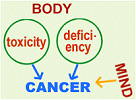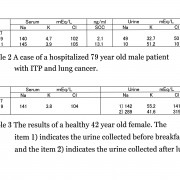Psychology, Cancer and Recovery
PSYCHOLOGICAL CONSIDERATIONS IN GERSON THERAPY
About how we must make sure that psychological factors do not sabotage the physical healing.
Also read about what to do, what steps to take if you have cancer.
Psychology, cancer and recovery
Any cancer diagnosis equals trauma with reactions ranging from despair and panic to apathy or rage, all of them powerful negative emotions. Psychoneuroimmunology tells us that feelings, moods and general outlook affect the immune system, which is boosted by a hopeful, determined outlook, and undermined by a despairing, helpless attitude. To put it simply, our every thought and emotion equals a biochemical act.
Dr. Gerson stated that more human beings die of panic than cancer. The body involves but one part of the illness. When the sickness also produces fear, the combination causes the accumulation of more and more toxins in the body and a quickening of deterioration. A better understanding of fear and the other negative emotions and what they do to the healing body is essential.
Since the aim of the Gerson Therapy is to rebuild the damaged immune system, we must make sure that psychological factors do not sabotage the physical healing. The patient’s traumatized negative inner state must be reprogrammed and made positive. Body and mind are inseparable, they sicken together, and must also be healed together. The patient must learn to handle these negative emotions or chances for success in regaining health will be greatly lessened.
Gerson patients bear an extra heavy psychological burden. Some come to the therapy after having run the gauntlet of orthodox treatment – extensive, unpleasant, uncomfortable and costly diagnostic procedures and examinations, biopsies, radiation, surgery and chemotherapy. The cancer patient has been especially traumatized by the widespread belief that nothing can be done for cancer, that it is, in the end, unbeatable. The patient and his family are depressed and, in many situations, taken over by the range of negative emotions: worry, grief, fear, anger, irritability, and self-centeredness. Other patients, striving at an earlier, less damaged stage, may have less difficulties. Either way, they embark on an unfamiliar treatment outside the bounds of orthodox medicine, and face a long, demanding, monotonous, lonely labor, with strong hope, but no guarantee of success at the end.
Negative emotions have a devastating effect upon the function of the body, and especially the nervous system.
Negative emotions have a devastating effect upon the function of the body, and especially the nervous system. The stress experienced from these emotions causes stimulation to autonomic or involuntary division of the nerves – both the sympathetic and parasympathetic branches. Blood pressure, heart rate, respirator rate, and oxygen consumption is increased. Glucose is needlessly used up. Kidney filtration, gastrointestinal secretions and activity are decreased, affecting digestion and the release of body wastes and toxins. Insomnia, fatigue, loss of appetite, listlessness, avoidance and boredom are noted.
On the other hand, positive emotions are powerful tools for healing. Norman Cousins, in his book Anatomy of an Illness has shown how important it is for the patient to mobilize his body’s own natural healing resources and has proved what powerful weapons all the positive emotions can be in the war against disease. Laughter, courage, tenacity, love and consideration for others and a connection to the patient’s own understanding of spirituality are all positive aspects essential for healing. Lacking these, the patient’s total healing will be slowed.
 According to a brief but precise definition, in holistic medicine the physician treats the patient, not the disease. This certainly applies to the Gerson Therapy, which heals by restoring the health of the whole body, rather than concentrating on a specific complaint. Its powerful effects extend to the patient’s nonphysical self as well. In order to make the Gerson program fully holistic, the psychological aspects of healing must also be considered.
According to a brief but precise definition, in holistic medicine the physician treats the patient, not the disease. This certainly applies to the Gerson Therapy, which heals by restoring the health of the whole body, rather than concentrating on a specific complaint. Its powerful effects extend to the patient’s nonphysical self as well. In order to make the Gerson program fully holistic, the psychological aspects of healing must also be considered.
Body and mind are two sides of one coin. They sicken together and must be healed together. Whatever affects the one will affect the other. Our task is to evoke the patient’s self-healing potential and make sure that some disregarded psychological problem does not sabotage the therapeutic process.
There is now solid scientific evidence to prove that our moods, emotions and general outlook have a direct measurable impact on our immune system. The proof comes from psycho-neuro-immunology (PNI), a new medical specialty that has been rapidly developing since the late seventies, thanks to a better understanding of brain chemistry and of the subtle connections that exist on the cellular level within the body. In a nutshell, the limbic system of the brain and the central nervous system release certain hormones that fit into receptor sites all over the body, causing them to release various secretions. The quality of the hormones and the secretion determines whether the immune system is boosted or weakened, switched on or off; and that quality, in turn, depends on our emotions, beliefs, and prevailing psychological orientation.
A positive, hopeful, determined attitude strengthens immune competence, while despair, negativity and fear weaken it. Lasting unhappiness or a traumatic event can overwhelm our cells. It is no exaggeration to claim that our every thought and emotion equals a biochemical act. In the words of neuroscientist Dr. Candace Pelt, co-discoverer of endorphins, “Cells are conscious beings that communicate with each other, affecting our emotions and choices.” It is equally true that our emotions and beliefs affect the activity of our cells.
Clearly, the patient’s emotional health is of vital importance if we want to ensure that the Gerson Therapy brings optimum results.
Any cancer diagnosis equals a major trauma. It evokes powerful emotions: panic, fear, rage, or, at the opposite pole, resignation, numbness, despair. Either way, most patients experience a sense of isolation, of being cast out of normal life and deprived of a future. Harrowing memories of personally known cancer victims arise – contributing to a superstitious fear of the disease.
This fear springs from two sources. One is rational, based on the very real threat of suffering, disfigurement, drastic treatments with vile side effects, and probably no cure in the end. But there is a non-rational fear as well, which sees cancer as an intruder, an evil alien that has breached our defenses and may kill us. In their panic-stricken state, very few patients realize that tumors don’t come from outer space but from the faulty functioning of their own bodies. All these emotions are negative, heavy, and distressing. They are made worse by the average physician’s response that is normally defensive and reserved, if not downright cold. [It was certainly cold in my experience when I was presented with a secondary tumor – my previously friendly surgeon-oncologist suddenly turned icy, implying with his manner that by producing a lump in my groin, I had somehow let the side down.]
If the patient then spends time in an average hospital, the additional handicap of dependence, loss of adult autonomy and privacy will make things even worse. The patient becomes a massive sufferer, with no say in what is being done to him or her. In the telling phrase of Ivan Illich, “Modern medicine turns the patient into a limp and mystified voyeur in the grip of bio-engineers.”
These observations apply to cancer patients diagnosed and treated in an orthodox medical framework. As almost all patients come to the Gerson Therapy from that system, we must recognize their depressed, fearful or numb state and do something about it – fast. Ordinarily, humanity demands that we try to relieve their sense of isolation, fear and hopelessness, by giving them time, space, and permission to unload their huge emotional burden.
Any cancer diagnosis equals a major trauma. It evoked powerful emotions: panic, fear, rage, or, at the opposite pole, resignation, numbness, despair.
Beside ordinary humanity, in the light of PNI’s findings, there are also sound medical reasons for urgently reprogramming the patients’ inner state from negative to positive. “No attempt should be made to cure the body without the soul,” wrote the Greek philosopher Plato nearly 2400 years ago. In today’s terms, even the brilliant Gerson program cannot do its best if something deep down in the patient’s consciousness keeps saying “No” to life.
That ‘something’ may be a totally separate diagnosis. It may have to do with what Lawrence LeShan, pioneer researcher of the body-mind link in malignant disease, dubbed “the cancer-prone personality”. Other researchers soon confirmed his observation that certain personality traits seemed to predispose some people to cancer. In LeShan’s formulation, these traits include low self-esteem, difficulty in expressing anger or aggression, and a tendency to please others and ignore his/her own needs and feelings. In other words, the true self of such a person has disappeared behind a false self, developed probably in early childhood and maintained in adulthood, although no longer necessary.
Naturally, this personality profile is only a model and does not apply to all cancer patients, although in my work with sufferers for nearly fourteen years, I have often come across these character traits. What matters is that – together or separately – they signal a negative outlook on life which a cancer diagnosis can turn into bleak despair. PNI tells us clearly what that means in trends of reduced immune competence.
It is well known that cancer often appears 18 months or two years after some untoward life even, such as bereavement, divorce, career crisis, fiscal blow, and so on. Experience with clients has shown me that those events only represented the last straw that ultimately broke the camel’s back; that, indeed, those people had long existed in what they had felt was a life trap, an impossible existential situation that apparently could neither be borne nor changed. LeShan and Carl Simonton, M.D., describe this life trap in detail. My own case material bears out its existence, and also the fact that those who feel unable to escape eventually reach a stage when they don’t care whether they live or die. As many of them have told me, “Something snapped.” I suspect it was the last strand of their will to live.
As the well-known saying has it, “Cancer is a socially acceptable form of suicide.” What we are dealing with here is the mysterious interaction of biochemistry and emotions, a vast new area of body-mind medicine that we are only beginning to explore. But there is already enough orthodox clinical, as opposed to anecdotal, evidence to prove that inner attitudes can make a big difference to survival.
In a new classical study, British researcher Stephen Greer interviewed a group of women three months after they had undergone mastectomies, to find out how they were coping. He found four distinct types among them who showed, respectively, fighting spirit, denial, stoic acceptance, and hopelessness. After 5 and 10 years, 80% of the fighters, but only 20% of the hopeless had survived. These rates had nothing to do with medical prognoses.
In the U.S., David Spiegel, M.D. of Stanford University, invited a group of 56 women with metastasized breast cancer to attend weekly meetings for a year, where they could share worries and sorrows, encourage each other, and change their mental attitude. A control group of 50 women attended no such meetings. Spiegel only wanted to discover whether the group activity enhanced the members’ quality of life, which it certainly did. But, to his amazement, he found that they also lived twice as long as the non-attenders.
These studies, as well as my own case histories, suggest that the fighters, unlike the despondent patients, give positive non-verbal messages to their bodies that boost their immune system, and get results accordingly. Not always: humanity’s mortality rate remains obstinately 100%, but we don’t all have to go at once.
Still, on the orthodox side, an interesting insight comes from U.S. oncologist-surgeon Bernie Siegal, M.D., author of several best-selling books which have helped to extend public understanding of the body-mind link in health and sickness. He claims that 15-20% of cancer patients unconsciously or consciously want to die, no doubt to get out of a bad life trap. 60-70% wish to get well, but are passive and expect the doctor to do all the work. 15-20%, however, are exceptional. They refuse to play victim, they research their disease, they don’t obey the doctor automatically but rather, they ask questions, demand control, and make informed choices. In Bernie Siegel’s words, “Difficult or uncooperative patients are most likely to get well.” Apparently they have more killer T-cells than docile patients. I suspect that many Gerson patients would qualify for membership in Bernie Siegel’s groups of Exceptional Cancer Patients.
So how do we go about promoting a positive outlook and a fighting spirit in the patient? The best I can offer is what I have learned and practiced over the years. The following steps refer to all patients with cancer or other chronic degenerative diseases. The specific needs of Gerson patients will be discussed afterwards. The first step is to de-mystify the disease, discuss it openly, in a natural voice, without euphemisms or technical jargon. This helps to provide a safe space where the patient can find emotional release, encouraged by being listened to with total, non-judgmental attention.
I always ask the initial question, “Do you want to live?” If the answer is yes, I ask, “Do you want to live unconditionally?” Another firm “yes” settles that matter. But often a “yes, but…” reply identifies an undecided individual, and the need for further exploration.
It is important to build a therapeutic partnership with the patient and give him or her responsibility and an active role to play. We must be totally honest; we must have the courage to say, “I don’t know” when we don’t refuse any kind of prognosis. If a patient tells us that 85% of people with his condition die in three years, we invite him to join the 15% who don’t. [I recall with joy and admiration the fragile little lady riddled with cancer who, when told that she had six months to live, brightly replied, “Oh good, I have six months to get well.” And get well she did, on the Gerson Therapy.]
So how do we go about promoting a positive outlook and a fighting spirit in the patient?
The 18-24 months of the patient’s life prior to the diagnosis can yield valuable clues. Did some major stress drive the patient to drink, drugs, or other destructive habits that caused significant liver damage? Gentle questioning often allows us to identify some life trap. The next task is to show that there is a way out, other than dying.
To flush out the inner saboteur, we need to help the patient recognize and release self-defeating patterns, old unwished business, and resentment – especially resentment, since the repeated reliving of old hurts, rage, or pain puts the autonomic nervous system into distress mode, which is the last thing the patient needs.
Reprogramming means shifting the emphasis from negative to positive. To quote LeShan once again, his basic question is “What’s right with you?” What are your special ways of being, relating, creating? What is blocking this expression? What do you need to fulfill yourself? Above all, what do you want to do with your life?”
I agree with LeShan’s claim that under the circumstances, it is permissible to ask questions which one would avoid otherwise. Questions like, If you had another thirty years to live, would you remarry your spouse, or stay with your partner, or remain in your present career?
Once these important basics have been clarified, it is time to switch from the passive to the active mode and point out the enormous potential open to the patient, if only he or she will act, not just react, and start making personal decisions. After all, there is nothing to lose.
If possible, the family dynamics should also be explored. A toxic relationship – to a spouse, an over-demanding parent or antagonistic children – may contribute to disease. Without recognizing the situation, there is no way to ease it.
A great deal can be achieved in a short time. The main tool of the physician or therapist is his or her personality and calm, reliable presence. Often this presence is the only solid support to the patient’s confused, chaotic world. Other tools, such as teaching relaxation techniques, simple meditation, and creative visualization, focused on self-healing, can and should be used later, by suitably trained counselors and therapists.
Beside the trauma and psychological needs experienced by cancer sufferers in general, Gerson patients have extra burdens to bear. Far too many come to the therapy as a last resort, after conventional treatments have failed them, leaving behind a sense of disappointment, betrayal, and a range of severe after-effects. For them, embarking on the Gerson Therapy is like taking a mad gamble, an end-of-the-line decision.
Others choose the Gerson path at an earlier, less serious stage of their disease, with fewer preventable changes in their bodies, but with a poor prognosis. Either way, they embark on an unfamiliar treatment, much of which sounds bizarre at first.
They step outside the boundaries of orthodox medicine, the network of doctors, consultants, hospitals, and referrals, a whole system which has been unable to heal them yet still cries an aura of great power. Some may have been shown the door by their physician. Others face pressure and doubts from family members and friends who don’t see how a weird, never-heard-of therapy can succeed where modern high-tech medicine has failed.
The would-be patient’s own doubts spring largely from the sheer length of the therapy. In the more familiar allopathic field of medicine there is a pill for every ill. You either recover or you die, but at least things happen fast. To face two years of unremitting effort, strict discipline and monotony sounds pretty horrendous, especially because there is no guarantee of success at the other end. This explains why only a small percentage of inquirers (In the U.K., the uptake is around 20%) choose to embark on the therapy after digesting the first batch of information.
We can assume a certain toughness and determination, or sheer despair, in those who are willing to make a start. At this stage, their main need is for reassurance, for sober hope mixed with honest realism. They need to hear that theirs is a serious disease indeed, but it is possible to recover from it, and the Gerson Therapy is the most logical way to regain their health. This is when the cognitive approach works best, explaining the “how” and the “why” of the Gerson program. It needs no medical background to understand why rebuilding the immune system is a better idea than knocking it out with radiation and a cocktail of toxic substances.
At this stage, having settled the emotional overload of the patient, we work along rational lines, explaining, answering questions, and not asking anything to be taken on trust. This reinforces the patient’s involvement in the healing process as an equal partner and ally of the doctor or specialist counselor.
To get an overview, it helps to imagine the two or more years of the Gerson Therapy as a drama in three acts.

Act One
acclaim stock photography.com Starting out: a time of excitement and exploration, unfamiliarity, drastic changes in lifestyle, diet and daily routine. There is much to learn all the time. It is a great advantage to start the therapy at a Gerson clinic. But, sooner or later, there follows the expulsion from that Garden of Eden where everything is done for the patient, and reality must be faced at home. For the patient who starts at home, chaos sets in – temporarily from Day One.
At first, the sheer tasks of the day seem impossible: preparing juices, food, enema coffee, washing up endlessly, securing deliveries, checking on the helper, cleaning up after the helper, and above all, remaining sane. At this stage, practical help is essential around the clock, to stop the patient from giving up at once.
Act One is so busy and active that there is little space and time for psychological matters.
Act Two
The main part (possibly the longest second act on Earth): The daily routine has been established and is rolling along. Even with helpers, it demands time, effort and perseverance. The monotony and boredom begin to tell on the patient who feels restricted, under virtual house arrest. In theory it is possible to go out after dinner, in practice it does not happen often.
Then there is the problem of flare-ups or healing reactions which can be vile yet have to be welcomed, since they signal that the body is responding to the therapy. By way of psychological support, the reasons and symptoms of flare-ups must be explained in advance, so that the patient does not panic (while feeling terrible). “This, too, will pass” is the best comfort we can offer.
An opposite problem, admittedly much rarer, is when there are no flare-ups for awhile, and the patient immediately concludes that the therapy is not working and there is no hope left. I remember my own despondency all those years ago when, except for one almighty flare-up, I did not have any for months. It really worried me. Then I had twenty-six in a row, which gave me something else to worry about.
Physical detoxification inevitably brings about psychological detoxification, too. Toxins passing through the central nervous system evoke strange reactions and out-of-character behavior: violent mood swings, snappiness, anger, instability, unfair accusations and aggression. The patient’s normally civilized behavior gives way to drives and emotions that have been denied and repressed for a long time, perhaps since childhood. The adult “censor” within is pushed aside by a raging infant, at least for awhile, and then takes over again, amidst profuse apologies.
This, too, has to be prepared for, and not taken personally. It is part of the process. In whatever capacity we work with the patient, we remain calm, caring, unchanged, waiting for the inner upheaval to pass.
However, we need to be more active if depression sets in. This, too, can be the result of the detoxification process, or of some small adverse symptom which is immediately seen as ominous. A bad result in the latest blood test or an apparent change in a a palpable tumor can plunge the patient into black despair. This has to be dispelled fast by pointing out that there are many ups and downs and fluctuations within the healing process. Single symptoms are not signals of doom.
Depression can also set in when the patient gets terminally fed up and wants to quit the therapy, although improvements are noticeable. It is best not to contradict the patient’s grumbles but, on the contrary, agree that the process is demanding, monotonous, restricting and boring. Point out the good results so far; ask tactless questions such as, “Would you rather have chemotherapy?” or “All right, you give up – and then what?” and wait for the answer. Remember: this, too, will pass.
Dr Gerson stated that more human beings die of panic than cancer. The body involves but one part of the illness.
Taking life day by day, one day at a time, is a good way to handle the apparent endlessness of the therapy, without losing sight of the ultimate aim. In fact, interim goal-setting – what would the patient want to achieve in one week, one month and three months – helps even further break up the monotony. The aims should be realistic and modest, and warmly acknowledged when they are achieved. Those that did not work out can be rephrased or postponed but not written off as failures.
Food can be a major issue during the main part of the therapy. Many people take to Gerson food at once and enjoy. Others do not. When resistance wells up and turns mealtimes into adult equivalents of nursed tantrums, we are up against the deep emotional investment many people have in certain types of food, however unhealthy. Their attachment is probably to the food mother gave them in childhood when food equaled love, even if it was low-grade junk. At a fraught time, such people may feel that what they eat is their last area of free choice. Although on a mental level, they accept the rightness of the Gerson diet, on a deeper, non-rational level, they reject it, sometimes literally.
This is where wise counseling is needed. The patient must be reminded that the food on offer is medicine, that the diet is not forever, and that accepting it now is a sound investment in the future. I have found it helpful to make a solemn contract with the patient who undertook to stick to the diet meticulously for a fortnight. As a rule, quick improvement followed, and extending the contract proved to be easy.
The need to observe the rules cannot be overstated. Small lapses and occasional exceptions, often asked for by patients, are out of the question, for what exactly is small, and how often does an occasional exception occur? Once the rules are broken, the safe boundaries of the therapy are damaged, and the consequences can be serious. However, as caregivers or therapists, we must enforce the rules with tact and affection, otherwise we may end up in the role of the over-strict parents, with “Thou shalt not” written all over us.
During the long main part of the therapy, the patient’s boredom can be relieved by providing relevant reading material and tapes, setting up networking with other Gerson Persons, and encouraging a fresh hobby or study that can be fitted in between juices, enemas and meals. Friends’ behavior can be crucial. Can they bear the patient’s illness and face their own fears, or do they fade out of the picture? And how are the family members coping? Are they bearing the burden of the therapy without making the patient feel guilty?
Act Three
Winding down: The intensive therapy is over. Now is the time to taper it off more and more, cutting down gradually on juices, enemas, and medication, and preparing to re-enter the world. This can be a very tricky phase. The same patients who used to ask, “Is there life after Gerson?” now are reluctant to let go of the routine. It has become a way of life that has served them superbly. They feel and look well, and they are symptom-free with good test results and no complaints – but, they do not want to come off the therapy.
At this point, it has become their safety device and symbolic life-and-health insurance, with the implied fear that stopping the therapy may bring on a relapse. This fear must not be dismissed lightly. It requires a careful, patient “weaning process” to ensure that the tube of the enema bucket does not turn into a substitute umbilical cord. Continuing with the therapy beyond the required period is not a good idea. Sticking with the dietary principles set out by Dr. Gerson is, on the other hand, very necessary for the rest of one’s life in order to safeguard one’s bravely rebuilt health.
There are others, of course, who have to be restrained from rushing back into their erstwhile disastrous eating habits at the end of Act Three. As a rule, the attempt is doomed: their detoxified, cleared, optimally nourished systems tend to shrink away from so-called normal food, heavy with fat and painfully salty. If their understanding does not object to junk food, their taste buds will.
In my experience, after recovery there is no way back into the pre-disease state. The experience of the holistic Gerson Therapy changes you, not only in your lifestyle and eating habits, but also in your value system, priorities and general outlook. You have been reborn without the need to die first, and you may easily and naturally decide to help others, by way of repaying a debt to life. According to Norman Cousins in Anatomy of an Illness p. 86:
“Increasingly, in the medical press, articles are being published about the high cost of the negative emotions. Cancer, in particular, has been connected to intensive states of grief, anger, or fear. It makes little sense to suppose that emotions exact only penalties and confer no benefits. At any rate, long before my own serious illness, I became convinced that creativity, the will to live, hope, faith, and love had biochemical significance and contribute strongly to healing and well-being. The positive emotions are life-giving experiences.”
Emphasizing positive emotions is by no means easy. Effort must be placed into coping with the negative emotions. The French Nobel physicist Marie Curie states, “Nothing in life is to be feared, it is only to be understood. Now is the time to understand more, so that we may fear less.” Understanding of the disease process and its cause should be the first step. Identifying the underlying cause will enable the patient to comprehend the purpose of the Gerson program.
A basic understanding of the Gerson program brings confidence and a willingness to become involved in such a rigid, comprehensive program. The critically ill will find it difficult to concentrate on this learning stage and the family or accompanying person must assist with this function. The simple act of understanding and accepting the Gerson Therapy takes away some of the fear. It shows there is hope of reversing the disease process.
Words, though, will not take away all of the fear. Results are really what counts. Early improvement in the diseased state will do more than anything else to resurrect hope. Many arriving patients have lost the will to eat and drink. The Gerson program helps the patient over this period, giving them simple foods and juices that the body is able to easily digest. There is a restoration of circulation. Body function picks up. The nervous system function improves. The patients begins to eat, drink, and sleep much better. Almost immediately, the patient begins to feel strengthened. Their interest in life is stimulated. For the first time since the patient heard his diagnosis and prognosis, he realizes that there can be a future.
A drastic change of lifestyle, the inevitable ups and downs and healing crises of the process mean a severe test for even the most committed patient. It is our job to lighten that burden with steady support, empathy, and well-focused counseling.
Tasks:
• Creating a safe space through total listening and non-judgmental attention.
• Building a healing partnership with the patient, turning him/her into an active ally, able to share responsibility for the therapeutic process.
• Dispelling the superstitious fear attached to cancer. Re-programming the patient’s consciousness, helping to reframe harmful concepts; identifying self-defeating patterns.
• Exploring the patient’s belief system and family dynamics. If the latter is negative or hostile to the therapy, reverse it.
• Dealing with resentment and unfinished business.
• Coping with the drastic mood swings and sometimes antisocial behavior that can accompany the detoxification process.
Tools:
• First and foremost, the physician/therapist’s own personality and calm, positive, reliable presence.
• Teaching relaxation techniques.
• Using simple meditations.
• Creative visualization linked to self-healing.
• Teaching affirmations.
Methods:
The cognitive approach is important. Patients are more willing to cooperate if they understand why they are asked to follow certain rules. Educating and developing the imaginative power of the right brain is equally valuable, as it complements and balances the purely mental approach. Besides, we are only beginning to know the therapeutic value of imaging work.








